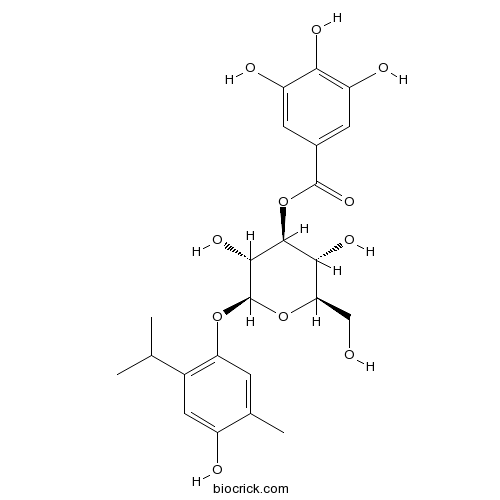IsoquerglaninCAS# 143519-53-3 |

Quality Control & MSDS
3D structure
Package In Stock
Number of papers citing our products

| Cas No. | 143519-53-3 | SDF | Download SDF |
| PubChem ID | 188924 | Appearance | Powder |
| Formula | C23H28O11 | M.Wt | 480.47 |
| Type of Compound | N/A | Storage | Desiccate at -20°C |
| Solubility | Soluble in Chloroform,Dichloromethane,Ethyl Acetate,DMSO,Acetone,etc. | ||
| Chemical Name | [(2R,3R,4S,5R,6S)-3,5-dihydroxy-2-(hydroxymethyl)-6-(4-hydroxy-5-methyl-2-propan-2-ylphenoxy)oxan-4-yl] 3,4,5-trihydroxybenzoate | ||
| SMILES | CC1=CC(=C(C=C1O)C(C)C)OC2C(C(C(C(O2)CO)O)OC(=O)C3=CC(=C(C(=C3)O)O)O)O | ||
| Standard InChIKey | FXEKONTUQLLWJB-JJYSZZJESA-N | ||
| Standard InChI | InChI=1S/C23H28O11/c1-9(2)12-7-13(25)10(3)4-16(12)32-23-20(30)21(19(29)17(8-24)33-23)34-22(31)11-5-14(26)18(28)15(27)6-11/h4-7,9,17,19-21,23-30H,8H2,1-3H3/t17-,19-,20-,21+,23-/m1/s1 | ||
| General tips | For obtaining a higher solubility , please warm the tube at 37 ℃ and shake it in the ultrasonic bath for a while.Stock solution can be stored below -20℃ for several months. We recommend that you prepare and use the solution on the same day. However, if the test schedule requires, the stock solutions can be prepared in advance, and the stock solution must be sealed and stored below -20℃. In general, the stock solution can be kept for several months. Before use, we recommend that you leave the vial at room temperature for at least an hour before opening it. |
||
| About Packaging | 1. The packaging of the product may be reversed during transportation, cause the high purity compounds to adhere to the neck or cap of the vial.Take the vail out of its packaging and shake gently until the compounds fall to the bottom of the vial. 2. For liquid products, please centrifuge at 500xg to gather the liquid to the bottom of the vial. 3. Try to avoid loss or contamination during the experiment. |
||
| Shipping Condition | Packaging according to customer requirements(5mg, 10mg, 20mg and more). Ship via FedEx, DHL, UPS, EMS or other couriers with RT, or blue ice upon request. | ||

Isoquerglanin Dilution Calculator

Isoquerglanin Molarity Calculator
| 1 mg | 5 mg | 10 mg | 20 mg | 25 mg | |
| 1 mM | 2.0813 mL | 10.4065 mL | 20.813 mL | 41.6259 mL | 52.0324 mL |
| 5 mM | 0.4163 mL | 2.0813 mL | 4.1626 mL | 8.3252 mL | 10.4065 mL |
| 10 mM | 0.2081 mL | 1.0406 mL | 2.0813 mL | 4.1626 mL | 5.2032 mL |
| 50 mM | 0.0416 mL | 0.2081 mL | 0.4163 mL | 0.8325 mL | 1.0406 mL |
| 100 mM | 0.0208 mL | 0.1041 mL | 0.2081 mL | 0.4163 mL | 0.5203 mL |
| * Note: If you are in the process of experiment, it's necessary to make the dilution ratios of the samples. The dilution data above is only for reference. Normally, it's can get a better solubility within lower of Concentrations. | |||||

Calcutta University

University of Minnesota

University of Maryland School of Medicine

University of Illinois at Chicago

The Ohio State University

University of Zurich

Harvard University

Colorado State University

Auburn University

Yale University

Worcester Polytechnic Institute

Washington State University

Stanford University

University of Leipzig

Universidade da Beira Interior

The Institute of Cancer Research

Heidelberg University

University of Amsterdam

University of Auckland

TsingHua University

The University of Michigan

Miami University

DRURY University

Jilin University

Fudan University

Wuhan University

Sun Yat-sen University

Universite de Paris

Deemed University

Auckland University

The University of Tokyo

Korea University
- 3',4',5',3,5,7,8-Heptamethoxyflavone
Catalog No.:BCN4927
CAS No.:21634-52-6
- α-Conotoxin AuIB
Catalog No.:BCC5975
CAS No.:216299-21-7
- 1alpha, 25-Dihydroxy VD2-D6
Catalog No.:BCC1299
CAS No.:216244-04-1
- Bis(2,6-diisopropylphenyl)carbodiimide
Catalog No.:BCC8879
CAS No.:2162-74-5
- β-Pompilidotoxin
Catalog No.:BCC1048
CAS No.:216064-36-7
- 1-Methyl-3-nitrophthalate
Catalog No.:BCC8468
CAS No.:21606-04-2
- 15,16-Epoxy-12S-hydroxylabda-8(17),13(16),14-triene
Catalog No.:BCN1491
CAS No.:216011-55-1
- 7-Hydroxy-beta-carboline-1-propionic acid
Catalog No.:BCN1492
CAS No.:215934-15-9
- CX 546
Catalog No.:BCC7532
CAS No.:215923-54-9
- Bruceine E
Catalog No.:BCN7619
CAS No.:21586-90-3
- SB-277011
Catalog No.:BCC1928
CAS No.:215803-78-4
- SB269652
Catalog No.:BCC8052
CAS No.:215802-15-6
- N-Demethylricinine
Catalog No.:BCC9098
CAS No.:21642-98-8
- Sophoflavescenol
Catalog No.:BCN2891
CAS No.:216450-65-6
- Bisphenol P
Catalog No.:BCC8891
CAS No.:2167-51-3
- Shoreic acid
Catalog No.:BCN4928
CAS No.:21671-00-1
- Fludarabine
Catalog No.:BCC2518
CAS No.:21679-14-1
- Kulinone
Catalog No.:BCN7954
CAS No.:21688-61-9
- Lauroscholtzine
Catalog No.:BCN4929
CAS No.:2169-44-0
- Z-N-Me-Ala-OH
Catalog No.:BCC3344
CAS No.:21691-41-8
- Z-DL-Nva-OH
Catalog No.:BCC3304
CAS No.:21691-44-1
- Procurcumenol
Catalog No.:BCN3555
CAS No.:21698-40-8
- Shyobunone
Catalog No.:BCN4930
CAS No.:21698-44-2
- 15-Epi-Danshenol-A
Catalog No.:BCN3146
CAS No.:216987-13-2
Superoxide anion scavenge effect of Quercus glauca Thunb. in whole blood of patients with ankylosing spondylitis.[Pubmed:9358904]
Am J Chin Med. 1997;25(3-4):307-15.
Nine phenolic compounds, catechin (1), epicatechin (2), gallocatechin (3), epigallocatechin (4), procyanidin B-4 (5), catechin-3-O-rhamnoside (6), rutin (7), querglanin (8) and Isoquerglanin (9) were isolated from oak leaves (Quercus glauca Thunb. Fagaceae), and the latter two (8, 9) were identified as new compounds. Several Quercus species have been used in folk medicine as an astringent for hemorrhoids and for treatment of inflammation, jaundice, and tumor. In this study, these compounds were tested for scavenging effects of the superoxide anion in the whole blood of patients with ankylosing spondylitis by means of an ultra-sensitive chemoluminescence (CL) analyzer and lucigenin amplification. The results showed that at a concentration of 2.3 x 10(-5) M, Isoquerglanin (9) displayed the strongest inhibition activity (73.55%), followed by querglanin (8) (68.81%) and then gallocatechin (3) and epigallocatechin (4) (66.97 and 60.17% inhibition, respectively). In addition, the blood chemoluminescence (CL) level of patients with ankylosing spondylitis was inhibited by superoxide dismutase (SOD) but not by catalase, suggesting that superoxide anion is the major component of reactive oxygen species (ROS) involved in this assay system.


